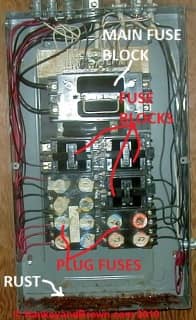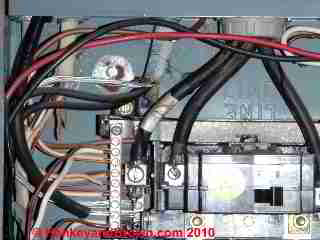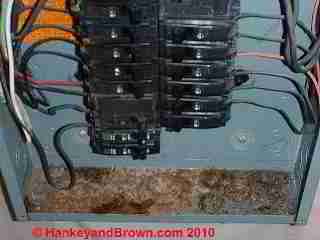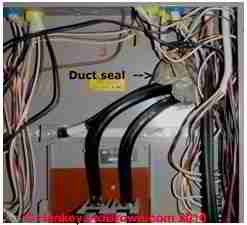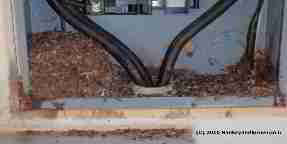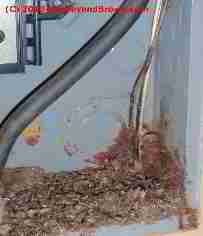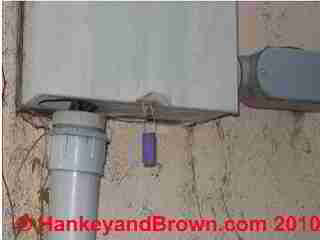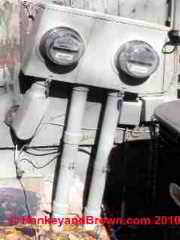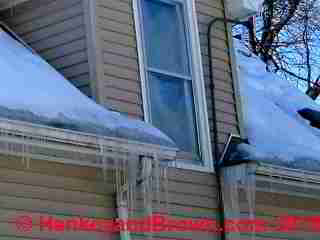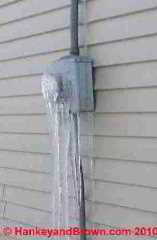 Sources of Moisture Intrusion and Corrosion in Residential Electrical Services
Sources of Moisture Intrusion and Corrosion in Residential Electrical Services
- POST a QUESTION or COMMENT about common & unusual causes & cures of rust, corrosion, moisture in electrical panels
This article discusses moisture movement methods, provisions of the National Electric Code intended to reduce the potential for intrusion, and three home inspections of wet electric service panels, each with a different method of water entry: flow along an overhead service drop, flow through an underground conduit, and condensation induced by humid air entering a panel in an air conditioned basement.
Photographs are included to illustrate the causes and paths for the moisture intrusion.
References to other cases are included, along with references to further information on the movement of moisture in buildings and corrosion in electrical panels.
InspectAPedia tolerates no conflicts of interest. We have no relationship with advertisers, products, or services discussed at this website.
- Daniel Friedman, Publisher/Editor/Author - See WHO ARE WE?
Moisture Intrusion and Corrosion in Residential Electrical Service Panels
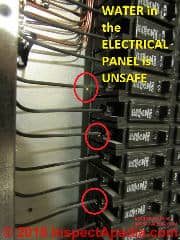 Roger Hankey, ASHI® Certified Inspector #269, orignal author, October 2010, & Daniel Friedman, Editor, InspectApedia.com & DovBer Kahn, photo contributor 2010 - 2018.
Roger Hankey, ASHI® Certified Inspector #269, orignal author, October 2010, & Daniel Friedman, Editor, InspectApedia.com & DovBer Kahn, photo contributor 2010 - 2018.
Photo: water droplets found in an electrical panel are never acceptable and create unsafe conditions. Even if there is no obvious or visible corrosion or damage, wet conditions invite hidden corrosion that can result in the failure of a circuit breaker to trip when it should in response to an over-current. The result risks fire, injury, or even a fatality.
Photo courtesy of Dovber Kahn, a Rockland County, NY home inspector.
[Click to enlarge any image]
Article Contents
- CORROSION & MOISTURE SOURCES in PANELS
- HOW WATER MOVES IN BUILDINGS
- STANDARDS VS. BUILDING MOISTURE
- INDOOR ELECTRICAL VS. MOISTURE
- ELECTRICAL PANEL MOISTURE CASES - surprising sources of moisture intrusion in electrical panels
- OTHER WATER INTRUSION IN PANELS
- NEC PROVISIONS on ELECTRICAL PANEL LEAKS
- HOW WATER MOVES IN BUILDINGS
Field study of sources of moisture & causes of corrosion in residential electrical panels.
ABSTRACT: The intrusion of moisture at electric service panels has the potential to cause corrosion and water damage to electrical equipment. While the design and installation of most systems keeps them dry, roughly 10% of residential systems suffer from moisture intrusion and corrosion1.
Home inspectors are tasked with examining electric service panels, typically in existing homes, for potential home buyers.
This article discusses moisture movement methods, provisions of the National Electric Code intended to reduce the potential for intrusion, and three home inspections of wet electric service panels, each with a different method of water entry: flow along an overhead service drop, flow through an underground conduit, and condensation induced by humid air entering a panel in an air conditioned basement.
Photographs are included to illustrate the causes and paths for the moisture intrusion. References to other cases are included, along with references to further information on the movement of moisture in buildings and corrosion in electrical panels.
Introduction to Water Problems in Electrical Equipment
Moisture intrusion means water, whether liquid, frozen, condensed or vaporized, that penetrates into a structure or behind the outside cladding of a structure.2
The presence of water, except in plumbing components designed to provide, receive, store, or remove water, and on exterior components designed to shed water, has the potential to damage building systems and components. Given the widespread presence of water in the environment, building components and systems usually are designed to reduce the potential for moisture intrusion.
How Water Moves in buildings - Basic Building Science
Manufacturers of electrical equipment recognize this omnipresence of water and specify product installation methods and maintenance to reduce the potential for moisture intrusion and remove water that enters the system. Success in diagnosing moisture intrusion begins with understanding the ways moisture moves. The four moisture transport mechanisms predominant in building science are:
- Liquid flow
- Capillary suction
- Air movement
- Vapor diffusion3
Liquid flow water movement is primarily influenced by gravity and wind. This method of moisture movement requires an entry point and path for the water flow to reach electrical components.
Capillary suction causing water movement is an important factor in moisture movement in many porous building materials but rarely occurs on non-porous metallic or plastic electrical components. Capillary suction can dampen a basement foundation wall. Many interior service or distribution panels are mounted on foundation walls. If the panel is not isolated from the foundation wall by an air space and a suitable mounting board, the moisture in the foundation wall can corrode the panel.
Moisture movement from air flow can occasionally be a factor leading to condensation in electrical equipment. The air flow can be caused by air pressure differentials, convection currents such the “stack effect” of rising warm air being displaced by falling cooler air, or by mechanical equipment such as fans and blowers.
Vapor diffusion (water vapor moving directly through permeable solid materials) is the moisture transport method that moves the least amount of water in a building, and is rarely a factor in introducing water into electrical systems which are composed primarily of non-permeable materials.4
Building & Home Inspection Standards vs. Building Moisture
Home inspection standards: The American Society of Home Inspectors® (ASHI) Standards do not require the inspector to determine compliance with regulatory requirements, (Sec. 13.2A8). However, a general knowledge of long standing regulatory requirements can serve as a basis for understanding why identifying and reporting moisture intrusion and corrosion in electrical equipment is an important aspect of a home inspection.
Wet or corroded electrical equipment are “components inspected that, in the professional judgment of the inspector, are not functioning properly”, as stated in ASHI® Standards 2.2C1, and therefore must be reported. The Standards also require opening the electric service panel.
The National Electric Code & moisture intrusion:
The National Electric Code (NEC) requires metallic electrical equipment be protected against deteriorating agents, including corrosion. NEC section 100 defines terms including:
Rain tight: Constructed or protected so that exposure to a beating rain will not result in the entrance of water under specified test conditions.
NEC 110.11 states “Unless identified for use in the operating environment, no conductors or equipment shall be located in damp or wet locations”; and NEC 110.12(C) states “There shall be no damaged parts that may adversely affect safe operation or mechanical strength of the equipment such as parts that are broken; bent; cut; or deteriorated by corrosion, chemical action, or overheating.”
NEC 300-6 (A) states: “Ferrous raceways, cable trays, cable bus, auxiliary gutters, cable armor, boxes, cable sheathing, cabinets, metal elbows, couplings, fittings, supports, and support hardware shall be suitably protected against corrosion inside and outside (except threads at joints) by a coating of approved corrosion-resistant material such as zinc, cadmium, or enamel. Where protected from corrosion solely by enamel, they shall not be used outdoors or in wet locations…”
Vulnerability of Indoor Electrical Components to Moisture
Many interior metallic electrical components are protected solely by enamel and therefore are not designed for contact with water. Moisture in electrical equipment can lead to:
- Corrosion of metal connectors, mountings, and conductors
- Potential for arcing/overheating at electrical components
- Potential for loss of electrical power on individual circuits should corrosion result in an opening of the circuit rather than a short.
- Short circuits in the electrical system
- Failure of circuit breakers to trip on overcurrent, increasing the risk of building fire. Infrequent short term entry of water typically does not cause breakers to trip or fuses to blow. However, chronic water entry can deteriorate insulation, corrode connections, and carry foreign materials into breakers or other unsealed components.
4 Case Studies of Moisture Entry into Electrical System Components
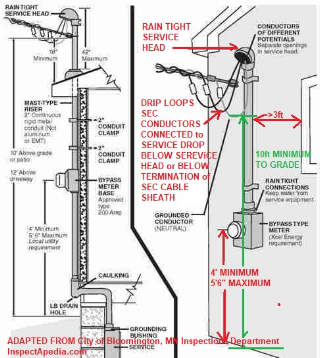 The following cases illustrate three ways moisture can enter electrical components.
The following cases illustrate three ways moisture can enter electrical components.
[Click to enlarge & see any image in higher resolution]
Electric services in the Twin Cities area of Minneapolis-St. Paul, Minnesota are nearly all installed using conduit.
Typical suburban homes have an underground service lateral from a ground mounted transformer to a meter box on the house near eye level and a raceway (conduit) descending to a short distance above grade with a 90 deg. elbow and a raceway through the rim joist to a main panel in the basement.
Others have a similar arrangement with the meter and service panel on either side of an attached garage wall.
Typical urban services have overhead service drops to a service mast head high on the wall or above the roof.
Drawing from City of Bloomington, MN Inspections Department.
[Click any drawing or photo for an enlarged, more-detailed version.]
Most electric service installations incorporate good workmanship and follow generally established practices. Therefore these systems stay dry. The infrequent presence of moisture in electrical panels creates a challenge for those who investigate water intrusion.
While multiple adverse conditions often lead to the moisture intrusion, those conditions are often subtle variations from normal. The first indication of trouble is usually found at the service panel
Water Entry into Electrical Panel Case #1 - Leaks at SEC
Photos in this article here and below © HankeyandBrown.com & InspectApedia.com 2010, 2018. [Click to enlarge any image]
Case #1 is an example of these subtle variations. The subject was a St. Paul, MN house built in 1911. The overhead electric service was wall mounted with a fused main panel in the basement, circa 1960.
The obvious adverse condition is the corrosion on the bottom of the panel.
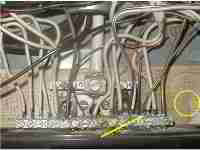 Upon close view there is also corrosion at the connections of the white neutral wires and the bare grounding wires above the “D” handle main disconnect.
Upon close view there is also corrosion at the connections of the white neutral wires and the bare grounding wires above the “D” handle main disconnect.
Notice a water drop on the connection bar and the stained paper label. An earlier initial examination at the overhead service drop did not suggest any concerns.
Given the presence of water and corrosion on the neutral bus, a closer second inspection of the service drop was done.
The service drop was a braided triplex cable descending from a utility pole to the rear wall. Two black ungrounded conductors each had a slight drip loop.
The white grounded conductor was slightly shorter and entered the mast head horizontally rather than from below.
(Photo below). Looking into the end of the mast head you can see how readily rain would follow the in-sloping white wire into the interior of the service entry conduit.
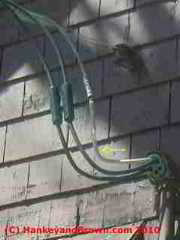
A further inspection of the service revealed staining on the bottom of the elbow where the conduit penetrated the wall. Our next photo (below) shows the under-side of the conduit elbow cover.
There was no drain hole in the bottom of this elbow.
Therefore, the probable moisture path was along the service drop, into the mast head on the white neutral conductor, down the mast, through the meter box, through the elbow and into the main panel to the neutral bus and finally onto the bottom of the panel.
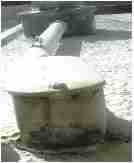
Photo (left) shows staining on conduit elbow under-side. [Click to enlarge any image]
The inspection report recommended a qualified electrician correct the drip loop, examine all the service components, and make any needed corrections to the service and fuse panel.
NEC references are not needed or helpful in an inspection report. However, they can help inspectors understand generally established design parameters and installation practices. Installations in substantial compliance with the NEC are less likely to have moisture intrusion.
NEC 225.22 Raceways on exterior surfaces of buildings or other structures shall be raintight and arranged to drain. (NEC frequently refers to conduits as raceways.)
NEC 230.52 Where individual open conductors enter a building or other structure, they shall enter through roof bushings or through the wall in an upward slant through individual, noncombustible, nonabsorbent insulating tubes. Drip loops shall be formed on the conductors before they enter the tubes.
NEC 230.53 Where exposed to the weather, raceways enclosing service-entrance conductors shall be raintight and arranged to drain.
NEC 230.54 Lists requirements of an overhead service that reduce the potential for water intrusion:
- (A) Raintight Service Head
- (B) Service Cable Equipped with Raintight Service Head or Gooseneck
- (C) Service Heads Above Service-Drop Attachment
- (D) Secured. Service cables shall be held securely in place
- (E) Separately Bushed Openings.
- (F) Drip Loops. Drip loops shall be formed on individual conductors.
- (G) Arranged That Water Will Not Enter Service Raceway or Equipment.
Water Entry into Electrical Panel Case #2 - Snow Melt
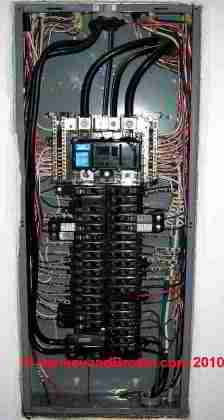
Case #2 of water leaks in an electrical panel involves an early April 2008 inspection of a rural property with a house built in 2006.
Heavy wet snow fell two days before the inspection. The snow was rapidly melting due to mild sunny weather.
The electric service panel was located on the basement wall adjoining an attached grade level garage. The first concern found was a wet floor near the service panel.
Water was flowing out of the service panel! [We moved our © notice up so that you can see the puddle of water on the bottom of the electrical panel enclosure.]
 Using gloves and great care (see SAFETY for ELECTRICAL INSPECTORS), the inspector removed the electrical panel cover, revealing water flowing from the service entrance conduit, onto the main breakers, cascading down the branch circuit breakers, and out the bottom of the panel.
Using gloves and great care (see SAFETY for ELECTRICAL INSPECTORS), the inspector removed the electrical panel cover, revealing water flowing from the service entrance conduit, onto the main breakers, cascading down the branch circuit breakers, and out the bottom of the panel.
Watch out: touching wet electrical system components or standing in or near wet areas during electrical panel inspections is dangerous, risks shock or electrocution, and should not be performed without the proper training and protective equipment.
The challenge in this case was to find the source of the water, which was draining into the electrical panel at about cup per minute.
The underground electrical service came to a electric meter box on a plywood panel erected about 20 feet from the attached garage (see next photo, below-left). The site near the service sloped toward the base of the meter stand.
The service then returned to the ground in a conduit. The sun had warmed the meter stand and melted the snow around its base. Further, a puddle of water had formed along the base of the garage wall.
These conditions were consistent with snow melt flowing subsurface above the frost line to a break or opening in the buried conduit permitting water entry and conveying water into the service panel.
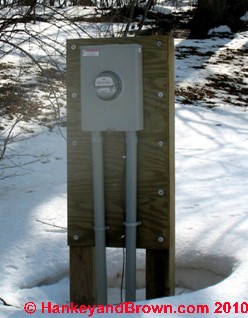
The photo at left shows the free-standing electrical meter monitoring the underground electrical service discussed above.
An interesting aspect of this case, aside from the adverse condition found, was that during a call to the seller to alert him to this condition, he replied: “Oh, I thought I corrected that last year.”
The inspection report recommended a qualified electrician correct this condition as soon as possible.
Water Entry into Electrical Panel Case #3 - Negative Air Pressure & Moisture Condensation
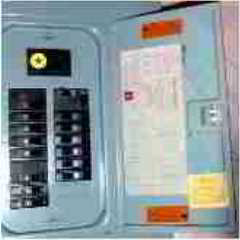
Case #3 of water intrusion into an electrical panel began with condensation found on the inside service panel cover door
This inspection was conducted on a hot humid day in July 2010. The panel was in a semi-finished basement of a house built in 1987.
Central air conditioning was keeping the basement very cool.
The only atypical condition found outside on the underground service entrance was a loose cover on the conduit elbow where the conduit entered the building by passing through a floor framing rim joist.
Removing the electrical panel cover revealed condensation throughout the panel including water dripping off wires and the neutral bus (yellow arrows, photo at below-left).
Our photo at left shows a drop of water hanging from the center of the red wire in the top of the electrical panel.
The bottom of the electrical panel (next photo below-left) was wet and corroded. A closer inspection of the service entrance conductors found no sealant in the open end or in the conduit elbow at the building exterior.
The air handler and loose return air ducts in the HVAC system created negative air pressure in the basement which drew in the hot humid exterior air via the joints in the electric meter box and the opening on the conduit elbow.
When this warm air met the cool service panel interior surfaces, condensation formed throughout the electrical panel and dripped to the bottom.
The recommendation in this case was to have a qualified electrician fully examine the service and make all necessary corrections.
Two NEC sections, if implemented, reduce the potential for moisture intrusion and corrosion:
NEC 230.8 Where a service raceway enters a building or structure from an underground distribution system, it shall be sealed …
NEC 300.7(A) Sealing. … where passing from the interior to the exterior of a building, the raceway or sleeve shall be filled with an approved material to prevent the circulation of warm air to a colder section of the raceway or sleeve.
Not the best repair: Our photo at left shows a different application of duct seal putty inside of an electrical panel. However, like the little Dutch boy with his thumb in the dyke at the very last possible point, stopping air, moisture.
This duct seal photo is not the same panel as the panel with the condensation (above), and while the two methods of sealing the conduit (interior and exterior) can be compared, they were not done on the same electric service.
Stopping water from entering an electrical panel, or any leak building leak for that matter, is usually better accomplished outside the building where the leaks originate.
See National Electrical Code Provisions Reduce Electrical Panel Water or Moisture Leaks, Corrosion for NEC code sections relevant to this moisture source.
For more technical advice on finding and correcting hidden air leaks in buildings see AIR BYPASS LEAKS and AIR LEAK DETECTION TOOLS.
Because condensation in an electrical panel or in / on any building interior surface is also a function of the relative indoor humidity, also see HUMIDITY LEVEL TARGET
Actual repair: Shown in our two photos below, the electrician correcting of this case applied putty known as “Duct Seal” around the conductors inside the service entrance elbow (below left) and cut a drain slot in the bottom edge of the elbow (below left, bottom of photo).
 ...
... 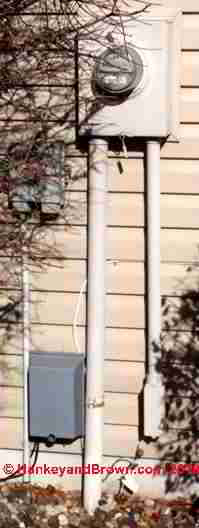
Also see SEWER GAS ODORS where we describe sewer gas leaks through electrical conduit.
Water Entry into Electrical Panel Case #4 - Mouse Infestation in the Electrical Panel
Case #4 of moisture intrusion into an electrical panel is an underground service feeding twin 200 amp panels on the rear wall of an attached garage at a 1994 built residence inspected in December 2010.
The service entrance conduit for this electrical panel (photo at left) had pulled out of the elbow leaving a gap of about an inch.
The movement of this conduit is consistent with soil compaction and probably occurred within three years of construction.
The interior wall of the garage had large junction box which contained the “Y” connections that fed power to two 200 amp distribution panels and the current transformers that drove the solid state electric meter.
The bottom of the junction box had rusty corners.
There were stains on the wall between the right panel and the junction box, and corrosion on the panel cover at the main breaker of the right panel.
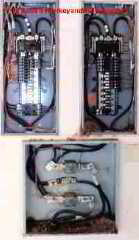
The gap in the service conduit was large enough to permit mice to enter the elbow and pass into the junction box.
Rodent nesting material was found in the bottom of the junction box and the right distribution panel.
The mouse urine had corroded the threads completely off the cover screws in the bottom of the right panel.
The bare copper grounding conductor in the lower right of the right panel had turned green where it was in contact with the nesting material.
Two dead mice were found: one on the left side of the right distribution panel and one in the junction box.
The recommended action was to have a qualified electrician clean out the box and panel as soon as possible, examine all components for damage, and make any needed repairs, including connecting the separated conduit on the exterior to prevent future mouse or insect infestation.
Other Sources of Water Intrusion / Corrosion in Electric Panels
Other conditions which can lead to water intrusion and corrosion in electric panels as well as other forms of damage include:
- Soil compaction (backfill settlement) which can pull down underground service laterals. An example and photo of an electrical meter pulled down the building wall due to backfill settlement over buried electrical conduit is found at ELECTRIC METERS & METER BASES.
- Siding installers who fail to call for remounting service equipment after re-siding the building (photos below left and right) More examples and photographs of electrical meters pulling away from building siding or left disconnected by the building siding installer are found at the electrical inspection safety article: Electric Meter & Service Entry.
- Poor roof drainage directing water onto service equipment.
Also see CORROSION in ELECTRICAL PANELS where we describe additional examples of sources of leaks into electrical panels and report on the most common water entry points and
see MOISTURE CONTROL in BUILDINGS for a discussion of keeping un-wanted leaks and moisture out of buildings.
A challenge that faces building and home inspectors is that corroded electrical panels are likely to be dry during the inspection and the conditions which created corrosion are typically elsewhere in the system.
To avoid the ice dam problems such as shown on the building above,
see ROOF ICE DAM LEAKS

Ice accumulating and meltwater dripping off a roof has covered the electric meter and meter pan in our photo at left.
In warm weather, clues indicating the presence of these troublesome moisture sources may not be apparent.
Water intrusion Inspection limitations:
Precisely because the visual inspection of a building on a particular day cannot be expected to detect problems that may appear only during other weather conditions, home inspection standards such as those published by ASHI® do not require a home inspector to determine the source of the moisture intrusion.
This task is left to electricians or to building forensic experts,.
But these examples suggest potential points of moisture intrusion.
Other potential sources of moisture and corrosion in electrical panels include:
- unvented clothes dryers,
- line drying clothes indoors,
- wet basements or crawl spaces,
- leaking pipes or plumbing fixtures,
- panels mounted on concrete or masonry without a backer board or air space,
- nesting insects and rodents (mouse urine is very corrosive), and
- makeshift showers or other amateur or improperly-installed plumbing fixtures near service panels.
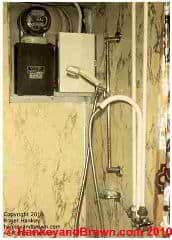 Watch out: extreme caution should be used when examining electrical equipment where water or moisture is present. When in doubt, leave further investigation of wet or corroded electrical services to qualified electricians with proper tools and the permission to shut the system down.
Watch out: extreme caution should be used when examining electrical equipment where water or moisture is present. When in doubt, leave further investigation of wet or corroded electrical services to qualified electricians with proper tools and the permission to shut the system down.
See SAFETY for ELECTRICAL INSPECTORS for more advice.
Watch out for homeowner or other amateur modifications that affect the electrical system and electrical safety.
This potentially lethal electrical installation combines what was probably an original location for an indoor electrical meter and a later project to "add-on" a bathroom shower.
Even inspecting this electrical system could be extremely dangerous.
See SAFETY for ELECTRICAL INSPECTORS.
National Electrical Code Provisions Reduce Electrical Panel Water or Moisture Leaks, Corrosion
The following NEC sections, if implemented, reduce the potential for moisture intrusion and corrosion:
230.8 Where a service raceway enters a building or structure from an underground distribution system, it shall be sealed …
300.7(A) Sealing. … where passing from the interior to the exterior of a building, the raceway or sleeve shall be filled with an approved material to prevent the circulation of warm air to a colder section of the raceway or sleeve.
-- © Roger Hankey, text and illustrations adapted with permission from the author.
Roger Hankey is principal of Hankey and Brown Inspections, Winter Park, CO. Mr. Hankey is a past chairman of the ASHI Standards Committee and served in other ASHI chapter and national leadership roles. Mr. Hankey is a National Radon Proficiency Program certified measurement professional and a Level II infrared thermographer. Contact Roger Hankey at: 970-393-6604 - rogerhankey47@gmail.com . Website: www.HankeyandBrown.com Mr. Hankey is a frequent contributor to InspectAPedia.com.
Most Common Water Enter Points into Electrical Meter Bases and Panels
Research of a large number of homes documented
at CORROSION in ELECTRICAL PANELS
found that at many electrical meters and panels the common leak points for water entry were found originating at the masthead, at frayed leaky service entry cable (SEC) insulation, at a poor seal of the SEC at its entry to the electrical meter base, or where the SEC penetrates the building wall passing to an electrical panel located lower than that pint, such as in a basement.
For those cases, the best repair would have been proper SEC installation details so that water was not entering the conduit and following the SEC cable in the first place.
In good building science it's generally better to keep water out of where it is not wanted than to let the water in and then let it run out.
White stains or "water tracking" marks
sometimes found on SEC wires entering the top of an electrical panel or at other wiring in an electrical enclosure or conduit may be caused by mineral deposits or debris left from water running down inside the SEC cable jacket or conduit into the enclosure or conduit. Examples of these conditions are found in photographs that track water moving inside the SEC, visible
at CORROSION in ELECTRICAL PANELS. - Ed.
Dov Ber Kahn, a home inspector in Rockland County, NY has contributed photographs of various building features. Mr. Kahn is a licensed home inspector in New York and New Jersey, and can be reached at Website: Kahnbhomeinspectors, Tel: 845-445-8234, Email: kdovber@googlemail.comos.
...
Reader Comments, Questions & Answers About The Article Above
Below you will find questions and answers previously posted on this page at its page bottom reader comment box.
Reader Q&A - also see RECOMMENDED ARTICLES & FAQs
Question: pulling wires through wet conduit
Electromotive action when : Electrical wires are pulled into conduit where the conduit has substantial level of standing water and the three wires are submerged in water!
Can this cause excessive current return on the natural wire from power company and causes excessives heating in all equipment running in the system ?
There is not any current on the ground wire at all ---- is just 3 - 5 mili-amps !
What is happening here and how does one fix the problem ?
Thanks - Travis Hopper - Bermuda ------ 1-441-505-2710 1/1/12
Reply:
Honestly, Travis, I don't know. I don't think the water itself is ever a cause of induced electrical current, though water inside conduit could, depending on level of impurities in the water, help conduct stray currents into wires that might be nicked or have damaged insulation.
I have found low levels of induced-electrical current in electrical wires in a variety of locations and installations where such wires ran under or even parallel to high current power transmission lines or service entry cables.
And all of us amateurs as well as pros working on electrical systems run across nicked or damaged wires that can then be measured to show unexpected currents.
A brother in law, a theater electrician, in wiring his New York City apartment with armored cable, over-tightened all of the BX-to-Box connector clamps and omitted the plastic wire protectors that should have been inserted into each BX wire end.
The result was that as he over-tightened the box connector clamp he squashed the cut-end of the BX cable armor enough that every single wire set in the apartment at every single junction box was nicked and connected (inadvertently) to the building ground. All of the nicked hot wires were found immediately when he tried to turn on power.
His GFCI breakers in the panel kept tripping - which was when he gave me a call. We found that the circuit neutral wires were also shorted to ground by the same clamp-cut mistakes.
I would inspect the system for damaged wires, and I'd look for a hot wire nick or leak. If no defects of that type are found I'd do some field tests to see if nearby power sources are inducing a current into the wire run.
Investigating a case of unexpected shock to workers who were rebuilding a garage (after an electrical catastrophe) we found that wet plywood roof sheathing was acting as a giant capacitor picking up a current induced by very close overhead power transmission lines.
Question: how do I stop water from pouring out of electrical conduit into the electrical system?
What is the permanent fix for this situation? I have built a sluice to catch the water that spills out of top of the wire conduit (into a 5 gal bucket) but I am worried about having so much constant water near an electrical source. I look forward to your answer. Thanks. - T.M. 12/31/2012
Reply: find the water source, direct it away, seal leaky conduit fittings
I agree that the conditions you describe are unacceptable and dangerous. A competent onsite inspection by an expert usually finds additional clues that help accurately diagnose a problem, though in this case, some detective work on your own part, as long as you can avoid getting shocked or killed, should be adequate.
To fix the problem you describe - water pouring out of an electrical conduit into an electrical box, panel, or control (any of these is unacceptable) we need to identify the water source as well as to identify all of the places (there may be more than one) where water is entering the conduit. The fix depends on what water sources and leak points we find.
Intercept & Direct Surface or Subsurface Water Away from Electrical Components
For example, where I found water entering a building electrical panel mounted on a basement wall, inspecting ouitside we found an in-slope grade towards that building wall and a buried electrical trench bringing the SEC feeders to the building. The trench, cutting a diagonal across the hill, was operating as a catch trench for both surface and subsurface water, aiming all of that water right at the building wall where the foundation wall was in turn penetrated by the entering electrical conduit.
Water was not actually entering the conduit in this case; water was simply following the conduit through the wall into the electrical panel.
The "fix" that worked to stop this wet electrical panel involved:
- cutting an additional drainage trench to direct water from the trench away from the foundation and over to a footing drain taken to daylight
- careful sealing of the building wall at the conduit penetration
Find & Fix Leaks into Electrical Conduit to stop water from entering electrical boxes & panels
A different and common example that may better fit your case is a leak, or more than one leak into an electrical conduit that is buried in ground exposed to surface or subsurface water, or rain entering an electrical conduit from above-ground, for example following an SEC down through the electrical meter box and from there into the interior of the conduit that in turn entered the building.
Some fellows think that if they just route the conduit "up" in a reverse drip loop they will stop this leak hazard. Some other wannabe electricians whose work I've inspected figured it was enough to drill a hole into an outdoor electrical conduit elbow bottom or junction box to let water in the conduit drain out before the wires enter the building.
I do not agree with either of these band-aid approaches to electrical conduit leaks.
Outdoor electrical boxes and conduit are expected to be weather-tight, not to serve as pipes that move water from one place to another.
And depending on water source, elevation, and pressure, such a loop is no guarantee that water doesn't enter the electrical system, and further, the wiring routed inside conduit and various junction boxes is not normally intended for exposure to water or flooding.
(Conversely, continuous, un-spliced UF underground feeder, outdoor exposure-rated electrical wiring may be buried outdoors, underground without protection by conduit.)
For leaks into electrical conduit, if the water quantity is small and the leak limited to one entry point, we might successfully expose and seal with proper fittings the leak into the conduit. But preferable is to direct water away from that point as well.
In your case, as you do not describe any investigation to pinpoint the water source, that's where I'd start. From the quantity of water you are describing I suspect that there may be a section of conduit buried outside in flooded soils and lacking proper connections, possibly even with one end open to the soil). You want to assure that the conduit is all water-tight throughout its length.
Any outside junction boxes that may have been required are either brought above-ground and also sealed, or are rated for below-ground water-tight use. .
Send along some photos of your installation and we may be able to offer further comments or suggestions, and keep us informed of what you find, as doubtless your own work will help other readers.
...
Continue reading at CORROSION in ELECTRICAL PANELS or select a topic from the closely-related articles below, or see the complete ARTICLE INDEX.
Or see these
Recommended Articles
- BACKWIRED RECEPTACLE FAILURE REPORT - corrosion of wiring and electrical connectors may be a factor in device failure, loss of power, flickering lights
- CIRCUIT BREAKER REPLACEMENT
- CORROSION in ELECTRICAL PANELS - Holm Conference Study
- CORROSION & MOISTURE SOURCES in PANELS - separate report, Hankey/Friedman
- ELECTRIC PANEL INSPECTION
- ELECTRIC POWER LOSS / FLICKERING LIGHTS
- ELECTRICAL INSPECTOR SAFETY PROCEDURES - clothing, and equipment for home inspectors and electrical inspectors.
- ELECTRICAL PANEL MOISTURE / WATER SOURCES - Holm Conference Study Details
- ELECTRICAL SERVICE DROP - mistakes can send water into the electrical panel
- FLOOD DAMAGE ASSESSMENT, SAFETY & CLEANUP
- GALVANIC SCALE & METAL CORROSION
- HOW TO TURN OFF ELECTRICITY in a WET or FLOODED BUILDING
- LIGHTNING DAMAGE to ELECTRICAL SYSTEM
- MOISTURE CONTROL in BUILDINGS
- RESTORE THE UTILITIES - after a building flood
Suggested citation for this web page
CORROSION & MOISTURE SOURCES in PANELS at InspectApedia.com - online encyclopedia of building & environmental inspection, testing, diagnosis, repair, & problem prevention advice.
Or see this
INDEX to RELATED ARTICLES: ARTICLE INDEX to ELECTRICAL INSPECTION & TESTING
Or use the SEARCH BOX found below to Ask a Question or Search InspectApedia
Ask a Question or Search InspectApedia
Try the search box just below, or if you prefer, post a question or comment in the Comments box below and we will respond promptly.
Search the InspectApedia website
Note: appearance of your Comment below may be delayed: if your comment contains an image, photograph, web link, or text that looks to the software as if it might be a web link, your posting will appear after it has been approved by a moderator. Apologies for the delay.
Only one image can be added per comment but you can post as many comments, and therefore images, as you like.
You will not receive a notification when a response to your question has been posted.
Please bookmark this page to make it easy for you to check back for our response.
IF above you see "Comment Form is loading comments..." then COMMENT BOX - countable.ca / bawkbox.com IS NOT WORKING.
In any case you are welcome to send an email directly to us at InspectApedia.com at editor@inspectApedia.com
We'll reply to you directly. Please help us help you by noting, in your email, the URL of the InspectApedia page where you wanted to comment.
Citations & References
In addition to any citations in the article above, a full list is available on request.
- CORROSION in ELECTRICAL PANELS , Daniel Friedman, 2009 report to IEEE HOLM conference on sources of rust and corrosion in electrical panels, surveyed the moisture sources by frequency of occurrence . This study reported that "An examination of field notes from more than a thousand private home inspections performed between 1987 and 1991 reveals rust and corrosion of various electrical components in 126 of 1052 service panels. More than one in ten service panels showed sufficient corrosion to merit, in the opinion of the inspector, report to the client of a possible safety or functional concern with the equipment."
- Oregon Administrative Rules, Construction Contractors Board, 812-012-0110
- Missing reference on vapor diffusion.
- "Increasing the Durability of Building Constructions", Dr. Joseph Lstiburek, Building Science Digest #144,www.buildingscience.com provides further discussion of moisture movement in buildings.
- Moisture Control Handbook: Principles and Practices for Residential and Small Commercial buildings, Joseph Lstiburek & John Carmody, 1993, Van Nostrand Reinhold, ISBN 0-442-01432-5, p15 also see Building Science Digest #144, Increasing the Durability of Building Constructions, Joseph Lstiburek. Quoting from Amazon.com:
... excellent introductory overview of practical problems and solutions relating to moisture control in buildings. The diagrams are outstanding! The emphasis is on moisture problems and solutions in low-rise framed buildings. My only disappointment is that the underlying physics are not described and that predictive techniques are not presented. An excellent reference book for builders, and a must read for anyone involved with trouble shooting, inspecting, insuring, repairing, and restoring building envelopes - CORROSION in ELECTRICAL PANELS, op.cit.
- Another interesting case of water intrusion in an underground service is told by Seattle ASHI® Certified Inspector Charles Buell in his blog at: http://activerain.com/blogsview/1865185/why-is-water-running-out-of-my-electrical-panel-
- Author: Roger Hankey is principal of Hankey and Brown Inspections, Winter Park, CO. Mr. Hankey is a past chairman of the ASHI Standards Committee and served in other ASHI chapter and national leadership roles. Mr. Hankey is a National Radon Proficiency Program certified measurement professional and a Level II infrared thermographer. Contact Roger Hankey at: 970-393-6604 - rogerhankey47@gmail.com . Website: www.HankeyandBrown.com Mr. Hankey is a frequent contributor to InspectAPedia.com.
- Technical Review: Kevin O'Hornett, ASHI, Prospex, of Boulder Colorado, P. O. Box 80 - Golden, Colorado 80402
Tel: (303) 517-1980. Mr. O'Hornett has served as the national director of education for ASHI, the American Society of Home Inspectors. 11/1/2010. Quoting:
PROSPEX owner Kevin O'Hornett has been a consultant and advisor throughout the U.S. and in Canada for the past twenty-two years. He also taught at Arizona SunTech from June of 2002 through May of 2004. Kevin has provided consulting services to various agencies and professions. - See MOISTURE CONTROL in BUILDINGS for a comprehensive guide to finding and correcting sources of un-wanted building moisture.
- [1] REPAIRING YOUR FLOODED HOME [PDF], American Red Cross & FEMA: Federal Emergency Management Agency, FEMA PO Box 2012, Jessup MD 20794-2012. Printed copies of this book are available from the American Red Cross, from your local Red Cross chapter, or by writing to the address above. Web search 10/4/2010, original source: http://www.redcross.org/www-files/Documents
/pdf/Preparedness/file_cont333_lang0_150.pdf - [2] The following are available free from:Federal Emergency
Management Agency
Attn: Publications
P. O. Box 2012
Jessup, MD 20794-2012
- Design Manual for Retrofitting Flood-prone Residential Structures, FEMA-114. This detailed manual explains all the floodproofing options in language a homeowner can understand.
- Elevated Residential Structures, FEMA-54.
- Floodproofing Non-residential Structures, FEMA-102.
- Coastal Construction Manual, FEMA-55.
- Manufactured Home Installation in Flood Hazard Areas, FEMA 85.
- [3] The following are available for
free from:
U.S. Army Corps of Engineers
Attn: CECW-PF
20 Massachusetts Avenue, NW
Washington, D.C. 20314
- Introduction to Flood Proofing, John R. Sheaffer, 1967
- Flood-Proofing Regulations, U.S. Army Corps of Engineers, Pittsburgh District, 1990, 80 pages (Corps publication EP 1165 3 314).
- Flood Proofing Systems & Techniques, L.N. Flanagan, editor, 1984
- Flood Proofing Tests, Tests of Materials and Systems for Flood Proofing Structures, Corps of Engineers, National Flood Proofing Committee, August, 1988.
- Raising and Moving the Slab- On-Grade House, Corps of Engineers National Flood Proofing Committee, 1990.
- [4] The following publications are
available from the American Red
Cross. Contact your Red Cross
chapter for more information:
- Your Family Disaster Plan (ARC 4466)
- Su plan para el hogar en caso de desastres (ARC 4466S)
- Your Family Disaster Supplies Kit (ARC 4463)
- Su Equipo de suministros para la familia en caso de desastres (ARC 4463S)
- Safe Living in Your Manufactured Home (ARC 4465)
- Are You Ready for a Flood or Flash Flood? (ARC 4458)
- ¿Está preparado para una inundación or inundación súbita? (ARC 4458S)
- Are You Ready for a Hurricane? (ARC 4454)
- ¿Está preparado para un huracán? (ARC 4454S)
- [5] Clean up References Many Cooperative Extension Service offices have home economists and food and farm experts. Check your telephone book under the county name. For example, if you live in Pittsburg County, check under “Pittsburg County Cooperative Extension Service”.
- [6] Questions on cleaning or disinfecting of specific materials can be answered by manufacturers of cleaning products. Check the product labels for toll free telephone numbers.
- [7] References on technical aspects of floodproofing can be located through the Floodplain Management Resource Center, a free service provided by the Association of State Floodplain Managers. Call 303/492-6818
- [8] CMHC, Canadian Mortgage and Housing Corporation, "After the Flood — A Homeowner’s Checklist", retrieved 10/21/2012, original source http://www.cmhc-schl.gc.ca/en/co/maho/em/em_001.cfm [copy on file as After_The_Flood_CMHC.pdf]
- Dr. Jess Aronstein, protune@aol.com is a research consultant and an electrical engineer in Schenectady, NY. Dr. Aronstein provides forensic engineering services and independent laboratory testing for various agencies. Dr. Aronstein has published widely on and has designed and conducted tests on aluminum wiring failures, Federal Pacific Stab-Lok electrical equipment, and numerous electrical products and hazards. See Aluminum Wiring Bibliography and see FPE HAZARD ARTICLES, STUDIES for examples.
- In addition to citations & references found in this article, see the research citations given at the end of the related articles found at our suggested
CONTINUE READING or RECOMMENDED ARTICLES.
- Carson, Dunlop & Associates Ltd., 120 Carlton Street Suite 407, Toronto ON M5A 4K2. Tel: (416) 964-9415 1-800-268-7070 Email: info@carsondunlop.com. Alan Carson is a past president of ASHI, the American Society of Home Inspectors.
Thanks to Alan Carson and Bob Dunlop, for permission for InspectAPedia to use text excerpts from The HOME REFERENCE BOOK - the Encyclopedia of Homes and to use illustrations from The ILLUSTRATED HOME .
Carson Dunlop Associates provides extensive home inspection education and report writing material. In gratitude we provide links to tsome Carson Dunlop Associates products and services.


